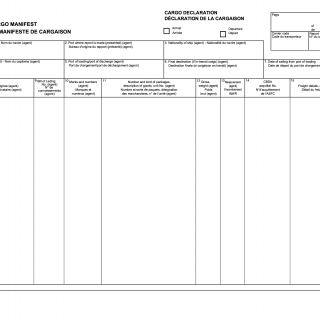Cargo Manifest (Sea Shipment)
The Cargo Manifest for sea shipments is a document required by various government agencies and shipping companies for all shipments transported by sea. The main purpose of the form is to provide information about the cargo being transported, including its origin, destination, and contents, to ensure compliance with customs regulations and to prevent the smuggling of illegal or prohibited items.
The Cargo Manifest for sea shipments consists of several parts, including the header section, the vessel information section, the port of loading and discharge section, the consignee and notify party section, and the cargo details section. The header section includes information about the vessel and voyage, such as the name of the vessel and the date of departure. The vessel information section includes information about the vessel and its operator, such as the name of the owner and the port of registry. The port of loading and discharge section includes information about the ports of loading and discharge, including the dates of arrival and departure. The consignee and notify party section includes information about the recipient of the cargo and any other parties who should be notified about the shipment. The cargo details section includes information about the cargo being transported, including the shipper and consignee names and addresses, the description of the cargo, and the weight and quantity of the cargo.
Important fields to consider when writing the Cargo Manifest for sea shipments include the description of the cargo, which must be accurate and detailed, and the weight and quantity of the cargo, which must be reported in the correct units of measurement. Additional documents that may need to be attached to the Cargo Manifest for sea shipments include commercial invoices, packing lists, and bills of lading.
Examples of applications and use cases for the Cargo Manifest for sea shipments include the transportation of goods for commercial purposes, such as international trade or business operations, as well as the transportation of personal goods, such as household items or personal effects.
Strengths of the Cargo Manifest for sea shipments include its ability to ensure compliance with customs regulations and prevent the smuggling of illegal or prohibited items. Weaknesses may include the potential for errors or inaccuracies in the information provided, which could result in delays or penalties. Opportunities for improvement may include the use of electronic forms or automated systems to improve efficiency and accuracy. Threats may include changes in customs regulations or security measures that could affect the requirements for the Cargo Manifest for sea shipments.
Related and alternative forms and analogues for the Cargo Manifest for sea shipments include the air and land cargo manifests, which serve a similar purpose for shipments transported by air or land. The main difference between these forms is the mode of transportation used. The Cargo Manifest for sea shipments affects the future of the participants by ensuring compliance with customs regulations and preventing penalties or delays in the transportation of goods.
The Cargo Manifest for sea shipments is typically submitted to the shipping company and the relevant government agencies electronically or in paper form, depending on the requirements of the specific port of entry or exit. The form is stored in the shipping company's records and may also be stored in government databases for review and analysis.

